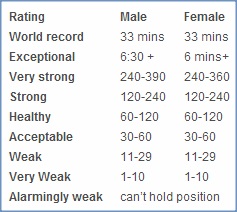Performing this test:
- The participant is timed while attempting to hold the plank position for as long as possible.
- Test ends when the participant’s plank position is no longer perfect.
Scoring:
What is a perfect plank position?
- Feet are spaced hip-width apart, toes flat to the floor with ankles positioned directly above the toes.
- Body is held in a straight line from heels to shoulders.
- Elbows contact the floor and are positioned directly below the shoulders
- Upper Arms are at a 90º vertical relative to the floor when viewed from the side.
- Glutes and Abdominals should be tight
- Back muscles should be relatively relaxed
Why do this test?
- It can provide a good indicator of your core and back strength.
- It’s a test that can be performed often, and can show large improvements over a short time frame.
- Test scores that are less than than prior attempts can indicate weaknesses due to fatigue and over training.
Things I like about this test:
- This is probably the easiest test to do and requires only a flat surface and a watch or a stopwatch.
- It requires no complex movements.
- It requires no special training. If you are working your core during your training, you are training for this test.
- You can conduct this test on your own.
- It is highly unlikely you would ever injure yourself doing this test.
- It will very quickly show you if you’ve been neglecting your core during your training.
Things I dislike about this test:
- It requires concentration to maintain a perfectly still posture, but if you concentrate to hard on the test you’re likely to “feel the burn” and end your test long before you might otherwise be capable of.
- It’s not a good test if you have a lower back injury, or if you’re lower back muscles are knotted or in spasm. While you can’t really injure yourself with this test, it is possible to exacerbate an existing injury if you don’t engage the correct muscles groups. Therefore technique is everything, and this requires that you really understand how to activate your abdominal core without over compensating with your back muscles.



Agreed. Much better than sit-ups which can place undue stress on the lower-back. Also, sit-ups can lead to a shortening of the iliopsis muscle which is not good or runners. Kim*
http://www.100days100ways.wordpress.com
Yeah, I’m starting to think that sit-ups are a kind of training evil, particularly because they are “supposed” to target the abdominals, yet they most often end up engaging all of the wrong muscles and causing more harm than good. Adequate stretching post workout can help to alleviate these problems, but if you can get a more targeted and less painful workout doing something else, you’re probably better off without them. 🙂